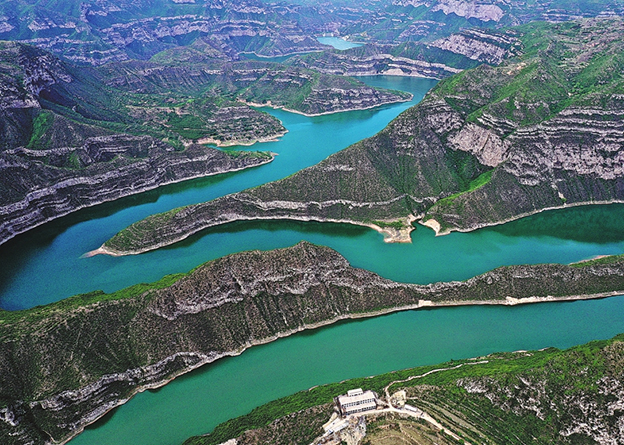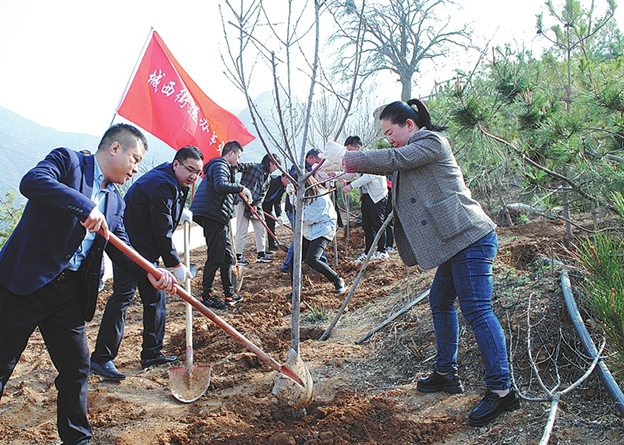
Shanxi\'s forest coverage hit 23.18 percent in 2019, surpassing the national average for the first time.

Volunteers in Yongji, a city in southern Shanxi, plant trees on March 12, China\'s Tree-Planting Day.
When the weather was getting warmer on March 12, thousands of volunteers in Taiyuan, the capital of North China's Shanxi province, went to the suburbs to celebrate National Tree-Planting Day.
Zhou Xifeng, a senior resident in Taiyuan, has volunteered in the tree-planting campaign for decades.
This time, she came to a site in Yangqu, a county in the north of Taiyuan, along with other volunteers of different ages.
"Today is the 40th anniversary of China's Tree-Planting Day. I am among the earliest volunteers engaged in tree planting since the very beginning," Zhou said.
Zhou, in her 60s, sees tree planting as a long-term hobby and she is regarded by many of her fellow volunteers as an "expert".
She said she was pleased with the site for planting trees. Zhou dug out some soil under the earth and looked at it closely.
"The soil has an ideal content of water and nutrition," she told her companions. "And the site also has plentiful sunshine. These make it a suitable place for planting trees."
The woman also shared her expertise on growing trees with the young volunteers.
"Chinese pines need to be watered frequently. When you plant Chinese scholar trees, you should trample on the soil to make it hard," Zhou said.
The 600-plus volunteers with Zhou planted more than 1,800 trees on that day.
The young people, especially the students, also regard tree planting as an opportunity to learn and get close to nature.
The students were taught the history of China's Tree-Planting Day and how the natural environment and people's lives can be changed by planting trees and grasses.
They learned that Shanxi had suffered environmental deterioration for several decades. This was to some extent a result of deforestation in the development of mining and agriculture.
They then learned that local authorities and residents are making painstaking efforts to restore the environment. Tree planting is one of these important efforts.
"In some regions of Shanxi, especially the dry areas in the north where the average annual rainfall is about 400 millimeters, growing a tree is harder than raising a child,"Zhou told the volunteers.
"However, our people have unshakable determination in cultivating their homeland because they believe that trees can help shield them from the frequent, devastating sandstorms and prevent the land from water erosion,"Zhou said.
Although March 12 is Tree-Planting Day, the tree-planting season in Shanxi can last from February to April, due to differences in latitude and altitude.
Usually, the tree-planting campaign starts in Yuncheng, a city in southern Shanxi, in early March and will spread north across the province until April.
Volunteers have played an important role in greening Shanxi and contributing to sustainable growth in the province, according to local authorities.
Statistics from the Shanxi Forestry and Grassland Bureau show that volunteers planted 250 million trees during the 13th Five-Year Plan (2016-20).
The province planted trees across an area totaling 1.54 million hectares over the five years. This raised its total forest coverage to 23.18 percent at the end of 2019, which surpassed the national average for the first time, according to a recent survey by the bureau.
China's forest coverage stood at 23.04 percent by March 12 this year, according to the National Forestry and Grassland Administration.
Officials at the provincial bureau said Shanxi plans to plant about 330,000 hectares of trees this year. In the next five years, it plans to plant more than 1.3 million hectares of trees. They predict its forest coverage will reach 26 percent by 2025.
In addition to its ecological benefits, the afforestation move in Shanxi has brought new opportunities for farmers to improve their incomes and livelihoods.
According to officials from the Shanxi Forestry and Grassland Bureau, the fragile environment with poor vegetation is one reason for poverty in some regions.
"Natural disasters including sandstorms, water and soil erosion, and floods are usually caused by the lack of vegetation," said an official at the bureau. "These posed major threats to agricultural activities and people's livelihoods over the decades."
Shanxi has implemented innovative reforms for the forestry industry, including compensation for returning farmland to forests and grassland; reforming the ownership and operational mechanism of forests; and encouraging the development of forestry cooperatives.
Forestry cooperatives are among the most popular form of rural cooperatives in Shanxi.
Wu Hailong, a farmer in Runlian village in Jiaokou county, is a member of a local forestry cooperative.
He said before he joined the cooperative in 2017, he lived in poverty because "we used to make a living by working on farms. Life was hard because of the lack of sufficient farmland and the harsh environment with frequent soil erosion during the rainy season".
"The cooperative brings an annual income of more than 30,000 yuan ($4,600) to my family and we were lifted out of poverty in 2018," Wu said.
In Kelan county, cultivation of the wild shrub sea buckthorn has developed into a huge industry benefiting people's livelihoods and the local environment.
While the native shrub has long been used by locals to break winds, stabilize sand and improve soil, it has recently become a major cash crop. Its fruits are rich in vitamin C and can be used to produce herbal teas and other health beverages.
The county is currently home to more than 30,000 hectares of seabuckthorn plantations. A number of enterprises are engaged in growing the plant, and producing and selling related food products.ompensation for returning farmland to forests and grassland; reforming the ownership and operational mechanism of forests; and encouraging the development of forestry cooperatives.
Forestry cooperatives are among the most popular form of rural cooperatives in Shanxi.
Wu Hailong, a farmer in Runlian village in Jiaokou county, is a member of a local forestry cooperative.
He said before he joined the cooperative in 2017, he lived in poverty because "we used to make a living by working on farms. Life was hard because of the lack of sufficient farmland and the harsh environment with frequent soil erosion during the rainy season".
"The cooperative brings an annual income of more than 30,000 yuan ($4,600) to my family and we were lifted out of poverty in 2018," Wu said.
In Kelan county, cultivation of the wild shrub sea buckthorn has developed into a huge industry benefiting people's livelihoods and the local environment.
While the native shrub has long been used by locals to break winds, stabilize sand and improve soil, it has recently become a major cash crop. Its fruits are rich in vitamin C and can be used to produce herbal teas and other health beverages.
The county is currently home to more than 30,000 hectares of seabuckthorn plantations. A number of enterprises are engaged in growing the plant, and producing and selling related food products.
wu jia contributed to his story.
ZHANG YANTING/FOR CHINA DAILY
 山西路桥:党建引领 建好“四好农村路”山西路桥建设集团党委扎实开展“党建质量提升年”,实施“六大工程”,立足“十四五”高质量、高速度、高效益发展的战略基点,全面提高党建质量和党建引领发展水平,为打造“国内一流的交通基础设施投资、建设、施工现代化企业集团”提供坚强政治保障。
山西路桥:党建引领 建好“四好农村路”山西路桥建设集团党委扎实开展“党建质量提升年”,实施“六大工程”,立足“十四五”高质量、高速度、高效益发展的战略基点,全面提高党建质量和党建引领发展水平,为打造“国内一流的交通基础设施投资、建设、施工现代化企业集团”提供坚强政治保障。
 常住人口3491万 山西人口普查数据"出炉"山西省统计局向社会通报山西省第七次全国人口普查主要数据。数据显示,山西省常住人口为34915616人,比2010年(第六次全国人口普查数据,下同)减少2.23%,年平均减少0.23%。山西省常住人口总量减少,主要受人口流动变化等因素影响。
常住人口3491万 山西人口普查数据"出炉"山西省统计局向社会通报山西省第七次全国人口普查主要数据。数据显示,山西省常住人口为34915616人,比2010年(第六次全国人口普查数据,下同)减少2.23%,年平均减少0.23%。山西省常住人口总量减少,主要受人口流动变化等因素影响。